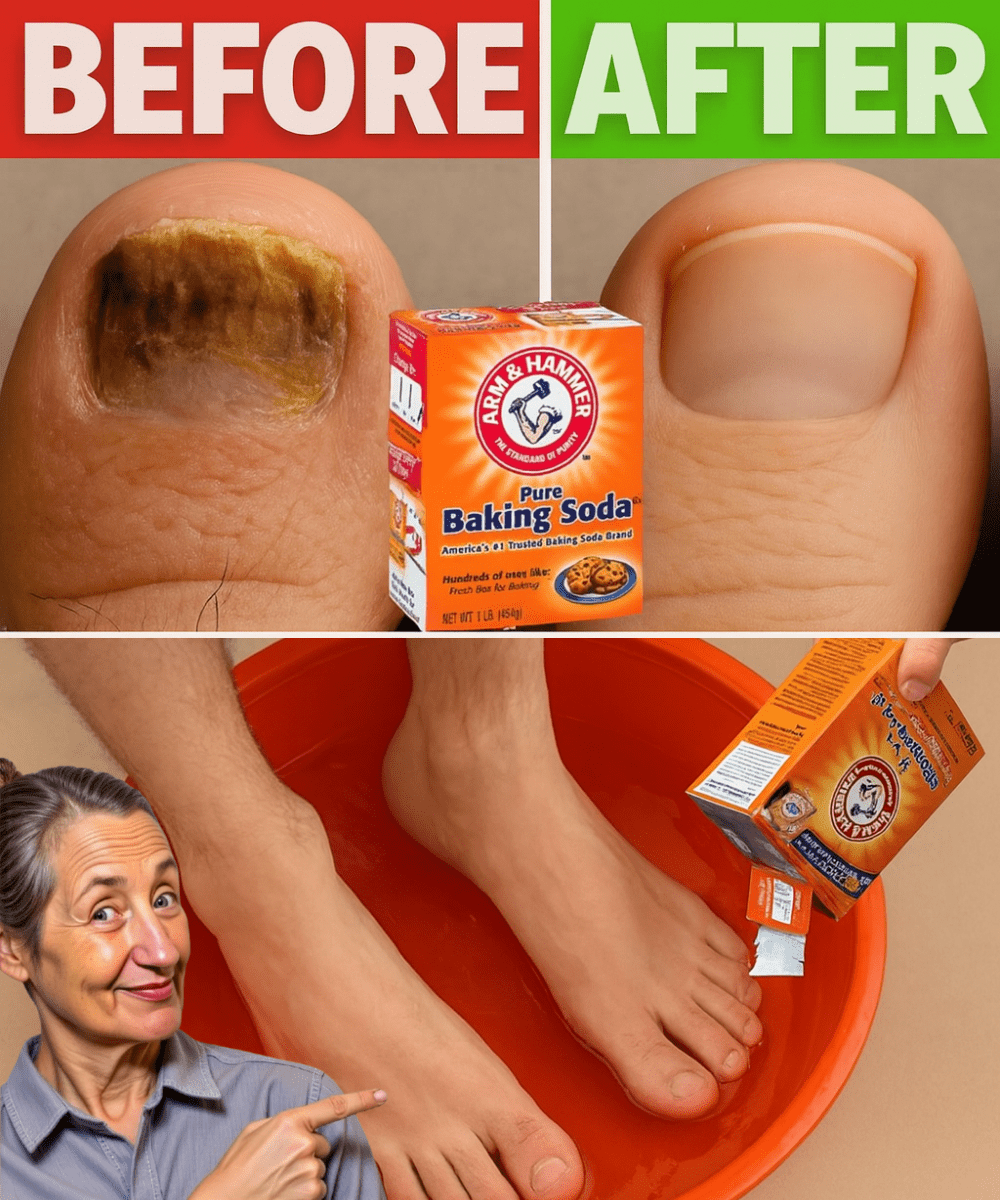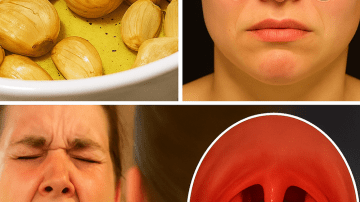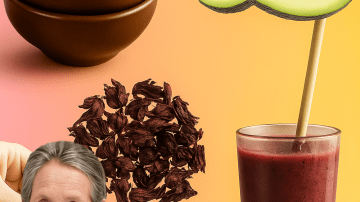What if a simple kitchen staple could transform the health of your feet, banishing the stubborn grip of toenail fungus? Baking soda, that unassuming powder tucked away in your pantry, is more than just a baking essential—it’s a natural remedy with the potential to restore your nails to their former glory. If you’ve been battling discolored, brittle, or thickened toenails, this guide will unveil how baking soda can become your go-to solution. Dive in to discover safe, effective methods to use this household hero, learn why it works, and unlock the confidence of healthy, beautiful feet.

🌟 Why Baking Soda Is a Game-Changer for Foot Health
Toenail fungus, medically known as onychomycosis, is a pesky condition that affects millions, causing embarrassment and discomfort. The idea of using baking soda—a common ingredient found in nearly every home—might sound too good to be true, but its natural properties make it a standout in the fight against fungal infections. Known for its antifungal, antibacterial, and alkalizing qualities, baking soda creates an environment where fungi struggle to thrive. Ready to reclaim your feet? Let’s explore how this humble powder can work wonders and why it’s capturing the attention of natural remedy enthusiasts everywhere.
🩺 Understanding Toenail Fungus: The Enemy Within
Before diving into remedies, it’s crucial to understand what you’re up against. Toenail fungus thrives in warm, moist environments like sweaty shoes or public showers, making feet a prime target. Symptoms include:
- Yellowing or discoloration of nails
- Thickened or brittle nails
- Foul odor or debris under the nail
- Pain or discomfort in severe cases
Left untreated, the fungus can spread, making early intervention key. Baking soda steps in as a natural, accessible way to combat this issue, offering a gentle yet powerful alternative to harsh chemical treatments.
💥 The Science Behind Baking Soda’s Antifungal Power
Why does baking soda work against toenail fungus? Its magic lies in its unique properties:
- Alkaline Environment: Baking soda, or sodium bicarbonate, raises the pH of the affected area, creating an inhospitable environment for fungi, which prefer acidic conditions.
- Antifungal Properties: Studies suggest baking soda can inhibit the growth of certain fungi, helping to stop the spread of infection.
- Exfoliating Action: Its mild abrasiveness helps remove dead skin and debris, keeping the nail bed clean and primed for healing.
- Odor Neutralizer: Baking soda tackles unpleasant foot odors, leaving your feet feeling fresh.
By combining these qualities, baking soda becomes a versatile ally in your fight for healthy nails.
🌿 Safe and Effective Ways to Use Baking Soda for Toenail Fungus
Ready to put baking soda to work? These simple, at-home methods are designed to maximize its antifungal benefits while being gentle on your skin and nails. Always use high-quality, pure baking soda and follow these steps for best results.
🛁 Baking Soda Foot Soak
What You’ll Need: Baking soda, warm water, a basin, towel
Instructions:
- Mix 2 tablespoons of baking soda with 4 cups of warm water in a basin.
- Stir until the powder dissolves completely.
- Soak your feet for 15–20 minutes, ensuring affected nails are fully submerged.
- Dry your feet thoroughly, especially between the toes, to prevent moisture buildup.
- Repeat daily for 4–6 weeks for noticeable results.
This soothing soak not only fights fungus but also relaxes tired feet, making it a perfect addition to your self-care routine.
🧴 Baking Soda Paste for Targeted Treatment
What You’ll Need: Baking soda, water, clean cloth or brush
Instructions:
- Mix 1 tablespoon of baking soda with a few drops of water to form a thick paste.
- Apply the paste directly to the affected nail and surrounding skin.
- Let it sit for 10–15 minutes, then gently scrub with a soft brush.
- Rinse and dry thoroughly.
- Use 2–3 times per week alongside soaks for enhanced results.
This method delivers concentrated antifungal action to stubborn areas, helping to clear infections faster.
🧦 Baking Soda Powder for Shoes
What You’ll Need: Baking soda, small cloth bag or shaker
Instructions:
- Sprinkle a teaspoon of baking soda inside each shoe or fill a small cloth bag with baking soda and place it inside.
- Leave overnight to absorb moisture and neutralize odors.
- Shake out excess powder before wearing.
- Repeat daily to keep shoes dry and fungus-free.
This simple trick prevents fungal reinfection by keeping your footwear clean and dry.
🛁 Baking Soda and Vinegar Combo Soak
What You’ll Need: Baking soda, apple cider vinegar, warm water, basin
Instructions:
- Combine 1 tablespoon of baking soda and 1 cup of apple cider vinegar in 4 cups of warm water.
- Soak your feet for 15–20 minutes.
- Rinse and dry thoroughly.
- Use 2–3 times per week for a powerful antifungal boost.
The combination of baking soda’s alkalinity and vinegar’s acidity creates a dynamic duo that targets fungus from multiple angles.
🌟 Tips for Maximum Results
To make the most of your baking soda treatments, keep these tips in mind:
- Consistency Is Key: Fungal infections are stubborn, so stick to your routine for at least 4–6 weeks to see improvement.
- Keep Feet Dry: After treatments, ensure your feet are completely dry to prevent fungal growth.
- Trim Nails Carefully: Keep affected nails short and clean to reduce fungal spread.
- Wear Breathable Shoes: Opt for leather or mesh shoes and change socks frequently to minimize moisture.
- Combine with Hygiene: Wash feet daily with soap and water to maintain a clean environment.

⚠️ Safety Precautions: Using Baking Soda Wisely
While baking soda is generally safe for external use, take these precautions to ensure a positive experience:
🩺 Consult a Professional
If you have diabetes, poor circulation, or severe infections, consult a doctor before starting treatment. Baking soda is not a substitute for medical care in advanced cases.
😷 Watch for Skin Irritation
Some people may experience mild irritation from baking soda. Test a small area first, and stop use if redness or discomfort occurs.
🚨 Avoid Open Wounds
Do not apply baking soda to broken skin or open sores, as it may cause stinging or irritation.
🤰 Pregnancy and Allergies
If you’re pregnant, breastfeeding, or have sensitive skin, check with a healthcare provider before using baking soda remedies.
🌿 Use Pure Baking Soda
Choose food-grade or pharmaceutical-grade baking soda to ensure purity and avoid additives that could irritate skin.
💡 Beyond Toenail Fungus: Other Benefits of Baking Soda for Feet
Baking soda’s versatility extends beyond fighting fungus. Here are bonus ways to pamper your feet:
- Odor Eliminator: Sprinkle baking soda in socks or shoes to neutralize odors instantly.
- Exfoliating Scrub: Mix with water for a gentle scrub to remove dead skin and soften calluses.
- Relaxing Soak: Add a pinch to warm water for a refreshing, stress-relieving foot bath.
🌟 Why Baking Soda Deserves a Spot in Your Foot Care Routine
Baking soda is more than a pantry staple—it’s a natural, affordable, and effective way to tackle toenail fungus and boost foot health. Its antifungal properties, ease of use, and versatility make it a must-have for anyone seeking healthier, happier feet. By incorporating these simple remedies into your routine, you can take confident steps toward clear, beautiful nails without relying on harsh chemicals.
Ready to try it? Grab that box of baking soda, start with a soothing foot soak, and commit to a consistent routine. With patience and care, you’ll be amazed at the transformation. Say goodbye to toenail fungus and hello to feet you’re proud to show off.
🦶 Final Thoughts: Step Into Confidence
Toenail fungus doesn’t have to hold you back. With baking soda’s natural power, you have an accessible, time-tested remedy at your fingertips. Embrace these safe, easy methods, stay consistent, and consult a professional for persistent issues. Your journey to healthy, vibrant feet starts with a single step—and a sprinkle of baking soda. Let’s make every step a confident one.






